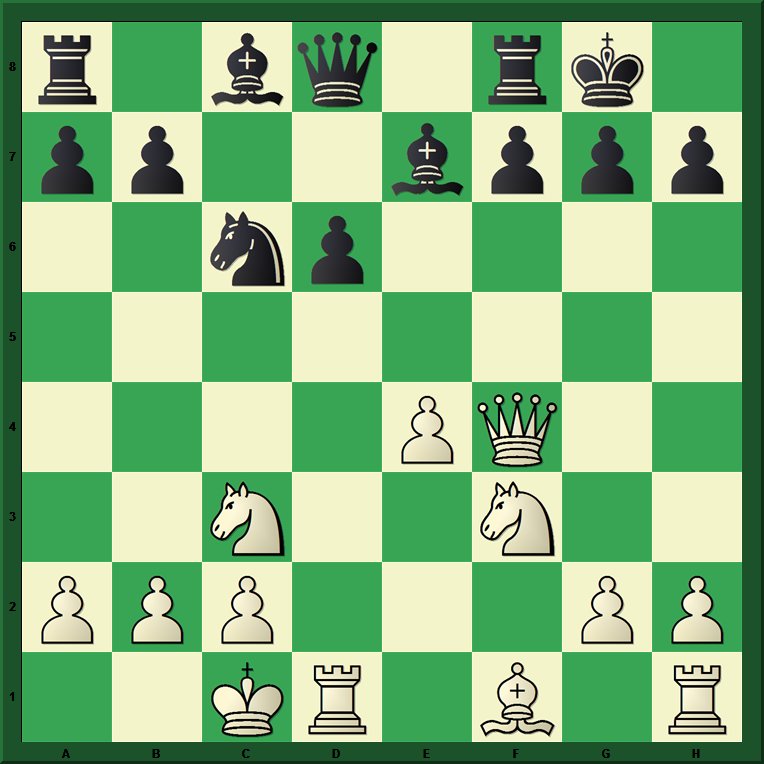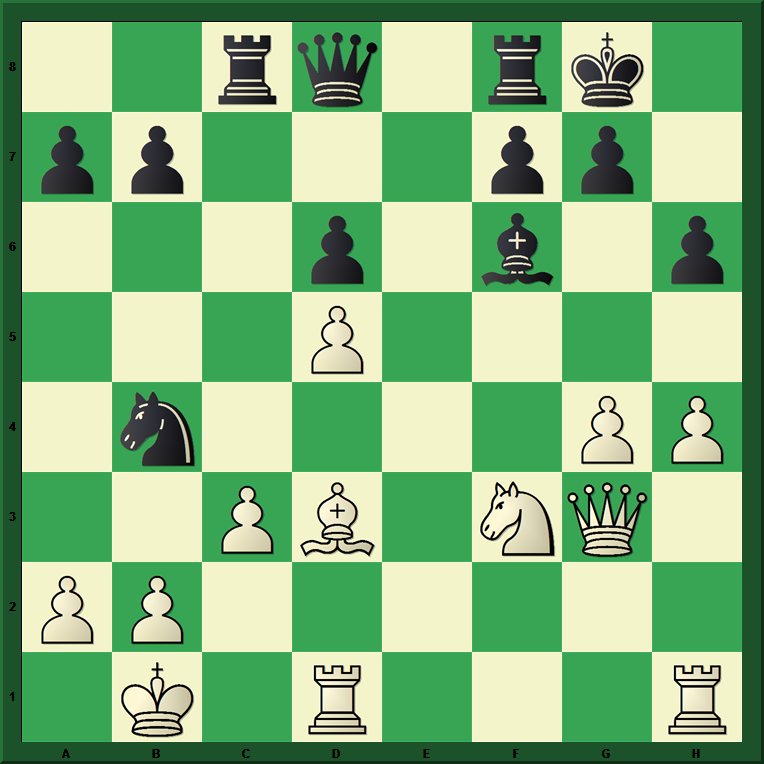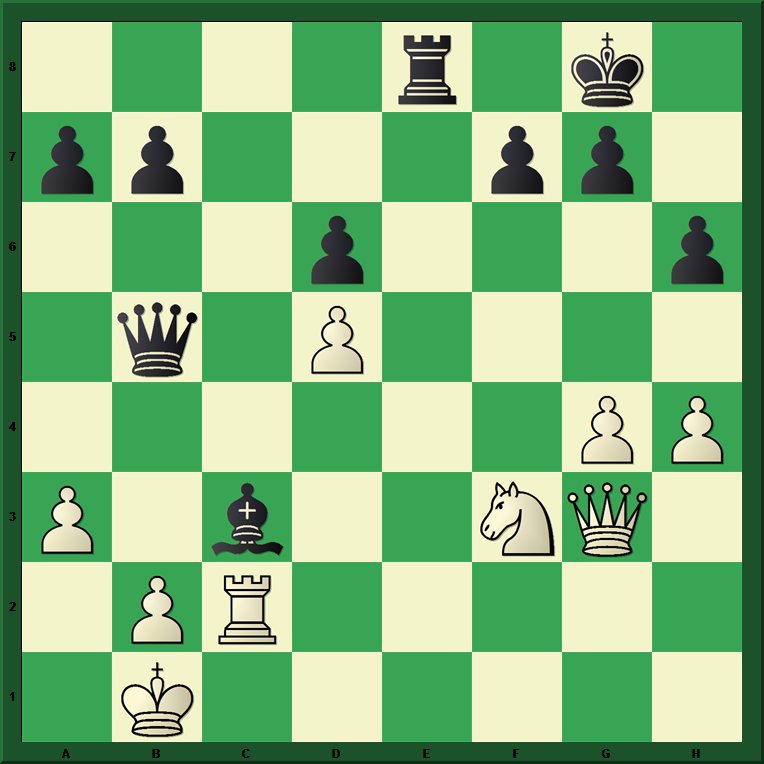All
the |
(Navigation bar
directly below.)
*******
© A.J. Goldsby, 2015.
(All rights reserved.)
****************
Click HERE
to see my
Chess Items.
****************
****************
Buy a book
from Amazon.com
(And help me out as well!)
****************
Click HERE
...
to see a list of the businesses that help to sponsor all of
my chess efforts.
"Chess Games" Problem of the DayWednesday; Sept 26th, 2012 |
Click HERE to see an explanation of the symbols that I commonly use when I annotate any chess game.
Click HERE to replay this game ... on another server. ---> Click HERE to watch my "You-Tube" video on this game.
GM Viktor D. Kupreichik (2570) -
GM Vitaly Tseshkovsky (2595);
|
|
|
[A.J. Goldsby I]
POTD /
Wednesday; Sept. 26th, 2012.
http://www.chessgames.com/perl/chessgame?gid=1087422
This was an interesting game -
so I decided to annotate it as quickly as I possibly could.
(If you have all the issues of the "Informant" series, this game was annotated by GM Vitaly
Tseshkovsky in issue # 33 ... game # 330.)
1.e4 c5;
2.Nf3 Nc6; 3.d4 cxd4; 4.Nxd4 e6; 5.Nc3 d6; 6.Be3,
This is a more modern treatment, the traditional line is the one that
begins with 6.Be2 here.
(See any opening manual.)
[ According to the metal monster ...
(and its deeply researched openings book) ...
White (& also Black) should transpose to the main line here with the following continuation:
(>/=) 6.Be2 Nf6; 7.0-0 Be7; 8.Be3 0-0;
9.f4 a6; 10.a4 Qc7; 11.Qd2,
"+/="
when White has a tiny edge.
[ See MCO-15, page # 292 ... columns # 1-2, and all notes. ]
A solid {current} game would be:
GM Artyom Timofeev (2558) - GM Pavel Smirnov (2539);
[B85]
The Russian Nat'l. Champ. (RUS-ch) / Krasnodar, RUS; (R#4) / 30,08,2002.
{A long draw - in around 70 moves.} ]
6...Nf6;
So far, its all book.
7.f4,
('!?') [Off-beat.]
A bit unusual, but not terrible.
[ PB recommends: 7.Bc4, "+/=" with a probable transposition to the (dreaded) Velimirovic Attack. ]
7...e5!?;
(Center-strike.)
This forces things, Black will also be fine after simple development, like 7...Be7.
(Placing the Black Bishop on e7 is the #1 choice of the PB.)
[Informant # 33 gives this move a dubious appellation, yet ... as far as I am concerned ... that is simply too harsh. "PB" (Fritz Power-Book) shows that this has been one of Black's more successful variations over the years. It is also the #2 choice of the computer's opening book.]
Now both sides continue their
overall development ... and even castle on opposite sides.
(This game would take a month to finish if I put this sequence under the microscope.)
8.Nf3 Ng4!?;
9.Qd2 Nxe3; 10.Qxe3 exf4; 11.Qxf4 Be7; 12.0-0-0 0-0;
(space / P-structure)
This is the current situation ...
|
|
r1bq1rk1/pp2bppp/2np4/8/4PQ2/2N2N2/PPP3PP/2KR1B1R w - - 0 0
Most engines agree that White is
solidly a little better here.
(I concur - White has more room, and I think that Black's
IQP is more difficult to defend than White's isolated KP.)
Now Fritz likes 13.Kb1, here.
(Me too.)
13.Nd5 Be6; 14.Kb1,
"+/="
Informant # 33 shows this position as being better for White, ("+/");
and that is essentially correct.
[ Also possible was: 14.h4!?, "+/=" with a small {solid} edge for White. ]
Of course - castling on opposite
sides - is a common occurrence in a lot of the lines in the Sicilian.
---> With that in mind, both sides continue to make fairly decent
moves ... plays that do fit in with the strategic guidelines and the overall plan for these types of
sharp positions. (A race to go get the enemy King!)
14...Rc8;
15.Bd3 h6!?; 16.g4!?, (Less than best?)
This was a bit too forcing, both 16.c3, (me) and 16.Rhf1, (Fritz);
looked to be a small improvement over the move actually played.
Black cannot allow White to
open the h-file ...
16...Bg5; ('!')
17.Qg3 Bxd5!?;
This might actually be a bit risky here, >/= 17...Bf6; looked safer.
(>/= ¹17...Bf6! is also the GM's recommendation in Informant #33.)
18.exd5 Nb4;
19.h4?,
This was all wrong. (inept)
[ One annotator - in 1982, in a chess magazine - gave this move 2 question
marks here. ]
[ Better was: >/= 19.Bf5! Rc4;
(Or if: 19...Bf6!? then 20.Bxc8, '±' winning the "ox" for White. )
20.Nxg5 Qxg5; 21.a3 Na6; 22.Qxd6, '±' (Maybe "+/-")
when Fritzie "thinks" that White is winning here. ]
19...Bf6;
20.c3?!, (ugh)
This was asking to get spanked, >/= Qf2[], was quite a bit safer.
|
|
2rq1rk1/pp3pp1/3p1b1p/3P4/1n4PP/2PB1NQ1/PP6/1K1R3R b - - 0 0
Now Black unleashes some nice
tactical blows ...
20...Bxc3!; 21.Rh2,
(An error?)
A natural reaction - but incorrect.
[ White probably had to play:
>/= 21.bxc3[]; ("Box.")
21...Nxa2!;
22.c4[], 22...Nc3+;
23.Kb2 Nxd1+; 24.Rxd1
Qb6+; 25.Kc2 Qa5;
"/+"
when its much more fun to play Black's side of this position, due to the
exposed nature of the White King. ]
21...Nxd3;
(Paring down.)
This was good, but Black actually had an improvement over this move!
[ Better was: >/= 21...Qb6!; "/+" (Have fun working it out ...) ]
22.Rxd3 Qb6;
23.a3 Qb5; 24.Re3?; (mistake)
This causes Fritz to show a red light ...
[ Much better was: >/= 24.Nd4
Bxd4; 25.Rxd4 Rfe8; "/+"
Black is a solid Pawn ahead, but it is no easy win. ]
Now
>/= 24...Qf1+!; leads to a forced win.
24...Rfe8; 25.Rxe8+ Rxe8;
26.Rc2?!, (Maybe - '?')
This was another error, White had to play 26.Qf2. "[]" ("Forced/Box.")
[ I should make it clear though, that White is already lost ... no matter what. ]
|
|
4r1k1/pp3pp1/3p3p/1q1P4/6PP/P1b2NQ1/1PR5/1K6 b - - 0 0
This is the current position.
Black now unleashes some nice tactics.
26...Bxb2!; 27.Rxb2 Qd3+!;
The most accurate.
[ Black can also win with: (RR) </= 27...Qf1+; 28.Ka2 Qc4+; 29.Ka1 Re3; "-/+" etc. ]
28.Ka2,
This was best/forced.
[ There were two other distinct possibilities, both were much worse for White.
*********************************************************************************************
#1.) </= 28.Ka1? Qxa3+; 29.Kb1, This was probably best.
(</= 29.Ra2? Qc1#.)
29...Qd3+; 30.Rc2 Re2; 31.Nd4[],
31...Qxg3; 32.Rc8+ Kh7;
33.Nxe2 Qxg4; "-/+" with an obvious win for Black.
*********************************************************************************************
#2.) White gets slaughtered after: </= 28.Kc1?? Rc8+; 29.Rc2[], 29...Qxc2#. ]
28...Qxd5+;
29.Ka1?!, ('?')
One final error.
(However, White was lost, and there was no way to save his game.)
[ The computer gives the following
convoluted line, as winning for Black,
but being a stiffer defense than what was actually played in the game:
>/= 29.Kb1 Qd3+; 30.Ka2, Probably best.
(Or 30.Rc2 Re2; 31.Nd4 Qxg3; "-/+")
30...Re3; 31.Qf2 Qc4+!; 32.Kb1
Rc3!; 33.Qd2[] Rxf3;
34.Rb4 Qf1+; 35.Qc1 Qd3+; 36.Ka2
Qe2+; 37.Rb2 Qe6+;
38.Kb1 Re3; 39.Rxb7 Re1; "-/+" (material advantage)
and Black has an obvious win. ]
29...Re3;
"-/+" (Black is winning.)
White sees no defense at all - so he throws in the towel here.
Copyright (c) A.J. Goldsby, 2012. All rights reserved.
0 - 1
The analysis for this page was prepared with the excellent program, ChessBase 10.0. (My engines are Fritz 12, Fritz 13, and Houdini 1.5.)
The HTML was polished with several different tools and programs, (mostly FP) ... the text was checked for spelling with MS Word.
|
Go ... or return ... to my Home Page for this site. Go (or return) ... to my "Annotated Games" (II) Page. Go
... or return ... to my "Best Games" Page. *******
Copyright (c)
LM A.J. Goldsby
I ******* This
page was first generated in: late-September, 2012. (Posted
on Wednesday / September 26th, 2012.) |


